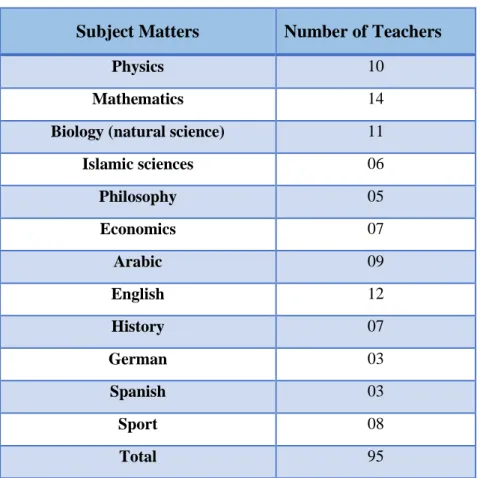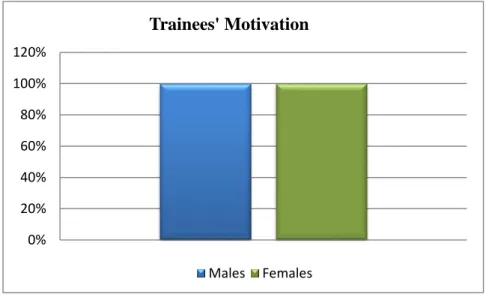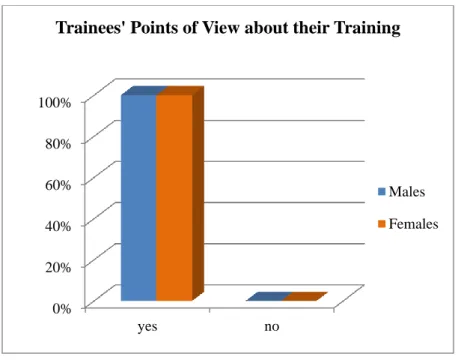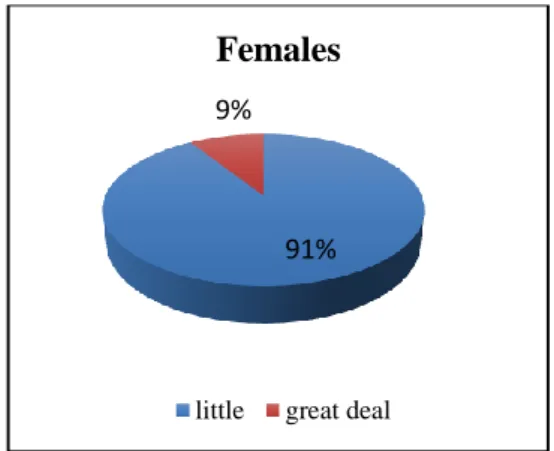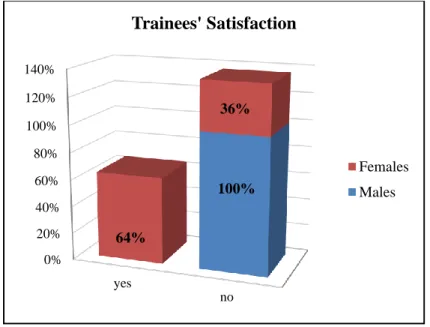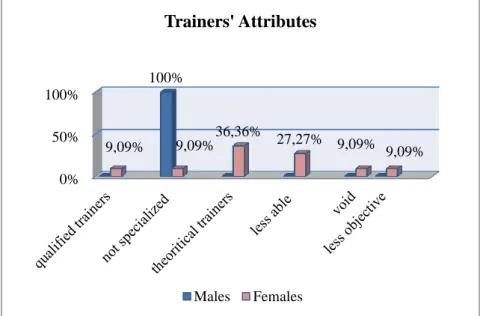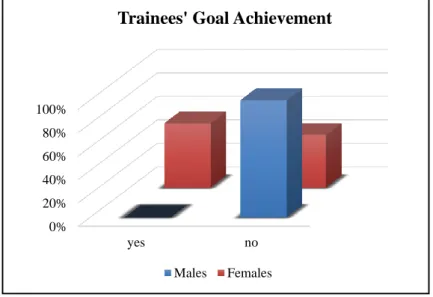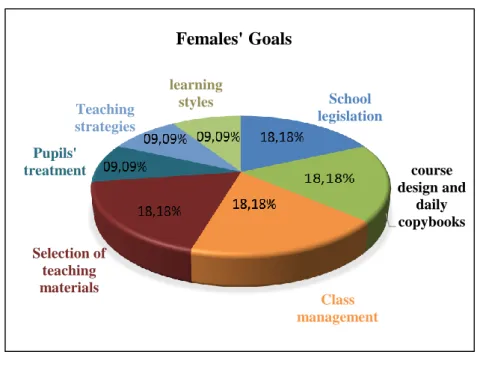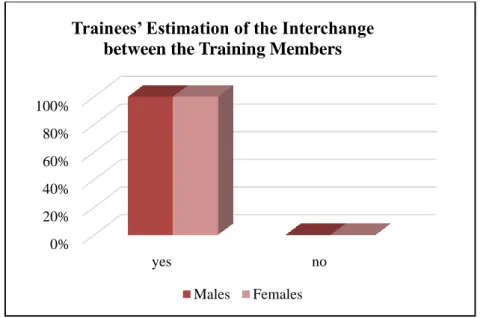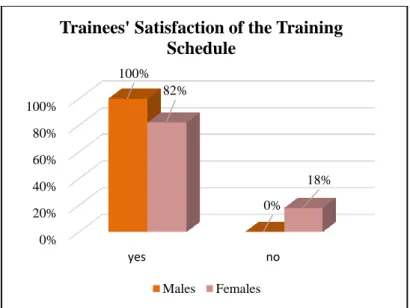PEOPLE'S DEMOCRATIC REPUBLIC OF ALGERIA
MINISTRY OF HIGHER EDUCATION AND SCIENTIFIC RESEARCH DJILALI LIABES UNIVERSITY SIDI BEL ABBES
FACULTY OF LETTERS, LANGUAGES AND ARTS DEPARTMENT OF ENGLISH
Thesis Submitted to the Department of English in Candidacy for the Degree of Doctorate in TEFL
Submitted by: Hadjer BRAHMI Supervised by: Dr. Nadia MENEZLA
Board of Examiners:
- Prof. Mohamed MELOUK (Prof) U.D.L. Sidi Bel-Abbés Chairman - Dr. Nadia MENEZLA (MCA) U.D.L. Sidi Bel-Abbés Supervisor - Prof. Belabbes OUERED (Prof) U.D.L. Sidi Bel-Abbés Internal Examiner - Prof. Fatiha KAID (Prof) ENS Oran External Examiner - Dr. Med Hichem GHAMBAZA (MCA) University of Saida External Examiner - Dr. BARAKA Abdallah (MCA) University of Mascara External Examiner
Academic Year : 2018 /2019
Acknowledgments
Acknowledgements
Through this dissertation, I present my sincere thanks to all those without whom this research would have never been accomplished:
At first, I would like to present my deepest gratitude to my supervisor Dr. N. MENEZLA for her infinite guidance, debriefing and feedback. I also thank her for her
intellectual generosity, valuable insight, advice, constant help and guidance she has provided me with throughout these five years of my post-graduation study (PhD thesis).
I am thankful to Prof. M. MELLOUK who has given me a chance to pursue my post graduation studies (2015-2019).
I appreciate the jury members as well who willingly accepted to read and evaluate my
work: Prof MELOUK.M, Prof OUERED.B, Prof KAID.F, Dr. GHAMBAZA.H, and Dr BARAKA.A.
My thanks go also to Dr.BOUGHERARA who in turn contributed in my research through her precious books.
Special thanks go to all the student teachers who kindly made themselves available to answer the questionnaires, and the university teachers that were respectfully asked to do the interview. Their participation was really significant.
Dedications
To my beloved parents, who have been supporting me, encouraging and helping me to realize my dreams.
To my friends and sisters: Warda, Khadidja, and Sara.
To my brother in law: Mohamed
List of Tables
Table1.1: Teaching Styles and Their Characteristics...16
Table 1.2: The Seven Pillars of Creativity...21
Table1.3: Time Allocation of ELT for First Year Secondary School...46
Table1.4: Time Allocation of ELT for Second and Third Year Secondary School...46
Table2.1: Teacher Training Stages...64
Table 3.1: The Number of the Trainee Teachers at Boukhari Secondary School...128
Table 3.2: Percentages of Trainees’ Motivation Towards Teaching English...131
Table 3.3: Percentages of Trainees’ Points of View about Their Training...132
Table 3.4: Percentages of How Much Beneficial the Pre-Service Training Was...133
Table 3.5: Trainees’ Satisfaction Concerning Their Pre-Service Training Courses...134
Table 3.6: Percentages of Trainees’ Opinion About Their Trainers...135
Table 3.7: Percentages of Trainees’ Goals Achievement...136
Table 3.8: Percentages of Females in Goals Achievement Examples...137
Table 3.9: Trainees’ Estimation of the Interchange between the Training Members...138
Table 3.10: Trainees’ Appreciation of the Training Schedule...139
Table 3.11: Features of the Pre-Service Training Environment...140
Table 3.12: Teachers’ Attitudes Towards the Existence of Other Subject Matters...141
Table 3.13: Trainees’ Readiness to Teach...143
Table 3.14: Percentages of Trainees’ Motivation Towards Teaching English...150
Table 3.15: Percentages of Competency-Based Approach Users...151
Table 3.16: Percentages of Trainees’ Teaching Methods...153
Table 3.17: Percentages of Teachers as Facilitators...154
Table 3.18: Percentages of How Often Teachers are Facilitators...155
Table 3.19: Percentages of Pupils’ Characters...156
Table 3.20: Percentages of Teachers who have got Disruptive Pupils...157
Table 3.21: Teacher Trainees’ Hindrances...160
Table 3.24: Trainees’ Preferences...163
Table 3.25: Sufficiency of In-Service Training Period...164
Table 3.26: Knowledge about Lesson Plan Preparation...165
Table 3.27: Whether Training Has Contributed in Shaping Teachers’ Personality or Not ... 166
Table 3.28: The Most Exciting Part In Teacher Training...167
Table 3.29: A Call to Observe Experienced Teachers...170
Table 3.30: Attendance of School Sessions...171
Table 3.31: A call to be observed by Experienced Teachers...172
Table 3.32: Efficiency of Training School Sessions...173
Table 3.33: Teachers’ Agreement to be Continuous Learners...174
Table 3.34: Teacher Training in Helping Teachers Being Professional...175
Table 3.35: Percentages of Teacher Trainers as Former Secondary School Teachers...182
Table 3.36: Percentages of Teachers Who Have Been Teacher Trainees...183
Table 3.37: Percentages of Teacher Training Usefulness...185
Table 3.38: Percentages of Teachers as Former ITE Trainers...187
Table 3.39: Percentages of CBA Appropriateness in Teaching...191
List of Figures
Figure1.1: Problem Solving Activity Steps...15
Figure 1.2: Structure of the Study...59
Figure 2.1: In-Service Training Models...91
Figure 3.1: Trainees’ Motivation Towards Teaching English...131
Figure 3.2: Trainees’ Points of View About Their Training...132
Figure 3.3: Training Benefits on Males...133
Figure 3.4: Training Benefits on Females...133
Figure 3.5: Trainees’ Satisfaction...134
Figure 3.6: Trainers’ Attributes...135
Figure 3.7: Trainees’ Goal Achievement...136
Figure 3.8: Females’ Goals...138
Figure 3.9: Trainees’ Estimation of the Interchange between the Training Members...139
Figure 3.10: Trainees’ Satisfaction of the Training Schedule...140
Figure 3.11: Females’ Opinion about the Training Setting...141
Figure 3.12: Males’ Opinion about the Training Setting...141
Figure 3.13: Teachers’ Attitudes towards the Existence of Other Specialties...142
Figure 3.14: Females’ Readiness to Teach...143
Figure 3.15: Males’ Readiness to Teach...143
Figure 3.16: Motivated and Unmotivated Trainees...150
Figure 3.17: Male Users of CBA...152
Figure 3.18: Female Users of CBA...152
Figure 3.19: Teaching Methods...153
Figure 3.20: Teachers as Facilitators...154
Figure 3.21: How Often Teachers are Facilitators...155
Figure 3.22: Pupils’ Characters...156
Figure 3.23: Problems with Disruptive Learners...157
Figure 3.26: Males’ Opinion about Training Efficiency...161
Figure 3.27: Females’ Opinion about Training Efficiency...161
Figure 3.28: In-Service Training Accomplishments...162
Figure 3.29: Trainees’ Preferences...164
Figure 3.30: Sufficiency of In-Service Training Period...165
Figure 3.31: Teachers who Learned How to Plan Lessons...166
Figure 3.32: Teacher Training In Shaping The Trainees’ Personalities...167
Figure 3.33: The Most Exciting Part for Males...168
Figure 3.34: The Most Exciting Part for Females...168
Figure 3.35: Males Who Were Asked to Attend School Sessions...170
Figure 3.36: Females Who Were Asked to Attend School Sessions...170
Figure 3.37: Attendance of School Sessions...171
Figure 3.38: A Call to be Observed by Skilled Teachers...172
Figure 3.39: Efficiency of Training School Sessions...174
Figure 3.40: Teachers are Continuous Learners...175
Figure 3.41: Teacher Training in Helping Teachers to be Professional...176
Figure 3.42: Teaching in Secondary School...182
Figure 3.43: Undertaking a Professional Training...184
Figure 3.44: Teacher Training Usefulness...186
Figure 3.45: Teachers as Former Trainers in ITE...187
Figure 3.46: CBA Appropriateness in Teaching...191
Figure 4.1: Reflective Teaching Practice...209
Figure 4.2:Microteaching Stages...222
Figure 4.3: Reflective Teacher Observation Programme...226
Abstract
The teaching profession is a challenging process that needs specific skills. This fact lets beginner teachers face various challenges when they move from the status learners to that of the teachers. However, teachers who undertake a good teacher education are expectedly those who achieve satisfactory learning outcomes. Therefore, this study, based on action research seeks to investigate the problems novice teachers encounter at the beginning of their career, and to figure out to what extent the present teacher training schools (after the suppression of the official training institute) are effective and helpful to the new entrant teachers. The study was carried out with a sample of English high school teachers at Sidi Bel Abbes, those who have just succeeded in the teaching contest and were called by the Ministry of Education to be teacher trainees first. Novice teachers face difficulties when they start teaching dues to the lack of training. To confirm or disconfirm this hypothesis, the researcher conducted a study based on a mixed method approach, where classroom observation and questionnaires were administered to the novice EFL teachers besides the interview which was accomplished by some university teachers (faculty of Letters, Arts and Languages) who used to be teacher trainers and high school educators. The study revealed a deficiency in teacher training course design. Subsequently, a number of recommendations and solutions were suggested to the novices who need to be prepared, sufficiently knowledgeable about their subject matter and efficient in their teaching practice.
Table of Contents
Acknowledgements...I Dedications...II List of Tables... ...III List of Figures... ...V Abstract... ... ...VII Table of Contents... ...VIII
General Introduction... ...1
Chapter One:Overview of Teaching and Research Situation Analysis...6
1.1. Introduction:...8
1.2.The Full Term of Education:...8
1.2.1. Definition of Education:...8
1.2.2. Importance of Education:...11
1.2.3. Teacher as an EFL Educator:...13
1.3.What is Good Teaching? ... ...17
1.3.1. A Good Mastery of Teachers’ Pedagogical and Content Teaching:...18
1.3.2. Creativity:...20
1.3.3. Socio-Affective Skills:...22
1.3.4. Personality:...24
1.4. Competency Based Approach (CBA) ... ...26
1.4.1. Definition of Competency Based Approach (CBA)...26
1.4.2. Characteristics of Competency Based Approach:...28
1.5.Information and Communication Technologies (ICT): ...31
1.5.1. Definition of Information and Communication Technologies:………31
1.5.2. Advantages of Information and Communication Technologies:...33
1.6.Challenges of the Teaching Profession: ... ...36
1.6.1. Heterogeneous Classes:...36 Maintaining Pupils’ Discipline:
1.6.3. Instructional Challenges (Didactics): ...40
1.6.4. The Need for Professional Support:...42
1.7. Algerian Educational System:...44
1.7.1. Teaching/ Learning English in Algerian Secondary Schools:...44
1.7.2. Description of the Training Setting:...47
1.8. Research Methodology and Tools: ... ...47
1.8.1. Aim of the Study:...49
1.8.2. Research Questions:...50 1.8.3. Research Hypotheses:...50 1.8.4. Target Population:...51 1.8.5. Research Instruments:...52 1.8.5.1. Pre-Service Observation: ... ...52 1.8.5.2. Pre-Service Questionnaire: ... ...53 1.8.5.3. In-Service Observation: ... ...54 1.8.5.4. In-Service Questionnaire: ... ...54 1.8.5.5. Interview: ... ...56
1.9. Significance of the Study: ...56
1.10. Structure of the Study: ... ... ...57
1.11. Limitations of the Study: ...60
1.12. Conclusion: ...60
2.1. Introduction: ... ...62
2.2. EFL Teacher Training: ... ...62
2.2.1. Definition of Teacher Training:...62
2.2.2. Teacher Training between Theory and Practice:...66
2.2.3. The Authenticity of Training Programs:...70
2.2.4. Types of Training:...73
2.2.4.1. Pre-Service Training: ... ...74
2.2.4.1.1. Novice EFL Teacher as a Pre-Service Trainee………...………..77
2.2.4.2. In-Service Training: ... ...80
2.3.1. Definition of Induction in Teaching:...86
2.3.2. Models of Induction Program:...89
2.3.2.1. Basic Orientation Model: ... ...89
2.3.2.2. Beginning Teacher Development Model: ...90
2.3.2.3. Transformation Induction Model: ...90
2.3.3. Mentoring: A Part of Induction Program:...90
2.3.3.1. Mentors’ Duties and Responsibilities: ...94
2.3.3.2. EFL Novice and Experienced Teachers: ...96
2.3.3.3. Inspectors’ Reflection on Teachers’ Performance: ...99
2.4. The Effectiveness of Training on Teachers’ Professional World:...103
2.4.1. Empowering Teacher Trainees’ Competences:...103
2.4.2. Collaboration:...107
2.4.3. Individual Teachers’ Personal Characteristics:...109
2.4.4. Impact on Pupils’ Achievement:...112
2.4.5. Professional Development:...115
2.4.6. Reducing the Teacher Drop-out Rate:...118
2.5. Balance between Training and Teaching: ...121
2.6. Conclusion: ...124
3.1. Introduction: ...126
3.2. Data Analysis and Results: ... ...126
3.2.1. Pre-service Training Observation:...127
3.2.2. Pre-service Training Questionnaire:...129
3.2.2.1. Discussion: ... ...144
3.2.3. In-service Training Observation: ... ...145
3.2.4. In-service Training Questionnaire:...148
3.2.4.1. Discussion: ... ...176
3.2.5. Former ITE Teacher Trainers’ Interview:...180
3.2.5.1. Discussion: ... ...196
4.2. Self-Assessment Processes: ... ...200
4.2.1. Reflection on the Teaching Practice:...201
4.2.1.1.Reflection in Action: ... ...202
4.2.1.2.Reflection on Action: ... ...205
4.2.1.3.Reflection for Action: ... ...207
4.2.1.4.Video Recording: ... ...209
4.2.1.5.Learners’ Feedback: ... ...212
4.2.1.6.Teachers’ Narratives: ... ...214
4.2.1.7.Logs/ Portfolios/ Journals: ... ...217
4.3.The Use of Microteaching... ...220
4.3.1. Peer Observation:...223
4.3.1.1. Pre-Observation Planning: ... ...229
4.3.1.2. During the Observation: ... ...230
4.3.1.3. Post Observation Debrief: ... ...231
4.3.2. Reciprocal Teaching:...234
4.4. Self Development Processes: ... ...239
4.4.1. Academic Seminars and Conferences:...244
4.4.2. Distance Education Approach:...248
4.4.3. Action Research : ...251
4.4.4. Online Mentoring and Coaching:...256
4.5. Conclusion: ... ... ...261
General Conclusion...262
References: ... ... ...266
Appendices...289
Appendix1: Training School Sessions’ Papers...291.291 Appendix2: A Reflective Lesson Plan...297...297
Appendix 3: Trainees’ Pre-Service Questionnaire...299
General Introduction
Education, due to globalization and many other factors, plays a vital role in broadening one’s knowledge background. It permits the learners to judge and see things from different angles in order that they can reach progress in any field. Education, as enlightenment to the illiterates, enables the individuals to see things from other perspectives. It also aids them to fight illiteracy and to be responsible citizens. As a part involved in the learners’ learning process, educators must awaken the learners’ curiosity and eagerness to know what the difference between knowledge and ignorance is.
Knowing English as a foreign language, from the other hand, paves the way to literate people to understand what is happening around the world and how to defend themselves against their enemies. Due to the valuable importance of English nowadays, Algeria has already included English as a subject matter to be taught in educational schools (middle and secondary) and even at universities, either as English for General Purposes (General English) or as English for Specific Purposes (ESP) in order to widen the learners’ knowledge and aid them to acquire the most needed skills for being academically and professionally proficient. However, teachers as guides and facilitators would determine how successful learners will be in the school.
The challenge of today’s novice teachers is to apply theoretical background in real life situations and respond to today’s demands and needs. As a result, prospective teachers have to be well trained to hold their responsibility over the future generation. For that purpose, Algeria has opened an official training institute for some time named: “The Institute of Technology and Education” that has been working for 27 years i.e. from 1969
Education (ITE) is a type of polytechnic university which specializes in education and prepares bachelors or high school graduates for being future teachers.
ITE essentially provides professional training to novice teachers in terms of classroom management, preparation f lesson plans, etc. Later, the institute closed its doors and it did not work anymore due to the appearance of universities and higher teachers training schools in Oran, Algiers and Laghouat. Algerian government then has authorized educational schools (primary, middle or secondary schools) as official training settings and asked retired and experienced teachers (more than 20 years of experience) to assume the role of trainers in preparing the novices for their professional carrier.
Like learning, teaching is an ongoing process which is supposed to be always updated. Teachers need to be equipped with relevant resources besides to their creativity in developing practical strategies for achieving the learners’ goals, like how to implement games or technologies in their lessons and activities. Teachers’ training is then perceived as an important part that leads to a successful teaching/learning process, especially for the novices who face numerous difficulties at their initial years of teaching: such as the misbehaviour of students, the change in educational programs, a lack of support from their colleagues, so on and so forth.
Due to the importance of training for novice teachers, the present research was conducted to explore the needs and problems that new teachers come across during their induction phase, attempting to propose a number of effective in order to reach valuable teaching quality. This study also aims at demonstrating the role of novice teachers and their awareness about the requirements and the demands of the teaching profession. In addition, it will determine whether the beginner teachers have been equipped with
sufficient and adequate knowledge and skills that enable them overcome their initial difficulties.
The main questions that this research endeavours to answer are:
1- How will novice teachers cope with the difficulties and the challenges they encounter in their teaching profession?
2- Does the ongoing teacher training meet the beginner teachers’ needs ?
3- Does teacher training have positive impacts on the student teachers and on pupils’ achievements?
Based on the above-mentioned research problematic, the researcher postulated some hypotheses as tentative answers which are as follows:
1- The novices are supposed to overcome the first challenges of teaching easily if they are well-prepared and well-trained for their job.
2- With the suppression of the official training institute (ITE), the present teacher training may to some extent provide the novice teachers with the most necessary teaching materials and aid them to achieve their educational goals.
3- Yes, teacher training makes a difference to both teachers’ performance and pupils’ achievements.
The investigator relies on triangle research instruments; observations (pre- and in-service), questionnaires (pre- and in-service) in addition to the interview. The target population, to which the results would be analyzed, are determined by beginner EFL secondary school instructors and former ITE teacher trainers, who have altogether contributed to gather adequate data for the present study.
As stated above, the research explores two main notions: the novice EFL teachers’ problems and challenges during the early years of teaching and the efficiency of training
that can help to minimize learners’ school failure. The present work, then, is composed of four main chapters.
The first chapter presents an overview about teaching in its broad term, and the implication of English language teaching in Algerian secondary schools. As a closure, a research situation analysis is assigned to show how the researcher has conducted the research; starting by the aim of the study, research questions and their hypotheses to specifying the target population (novice EFL secondary school teachers) that was chosen to participate in the selective research instruments at Boukhari secondary school.
The second chapter is mainly theoretical, meant to deal with the literature review of that topic (teacher training). It highlights the importance of training on the novices and how they handle their induction and mentoring period, citing a number of different induction program models, and the responsibilities of trainers over their English teacher trainees.
The third chapter is analytical as it presents and analyzes the results obtained from the research instruments (questionnaire, observation and interview) applied with EFL novice secondary school teachers and former English teacher trainers at ITE previously. The fourth chapter is mainly practical; it takes place at the end of the research framework in order to set some outstanding or probable solutions, namely recommendations and suggestions that may hopefully resolve the research questions.
Some limitations were encountered during the conduction of this thesis. There were not many EFL trainee teachers; only twelve novice teachers have passed the teaching contest and were able to respond to the designed questionnaires. Though these participants accepted to do so, they refused on the other hand to re-answer the questionnaires as a form
of a pilot study. Moreover, the investigator could not carry out an interview with the English language secondary school inspector; s/he did it with ITE former English teacher trainers instead so as to see how trainers view teacher training and its value for the neophyte teachers.
Chapter One:
1.1. Introduction:...8
1.2. The Full Term of Education:...8
1.2.1. Definition of Education:...8
1.2.2. Importance of Education:...11
1.2.3. Teacher as an EFL Educator:...13
1.3. What is Good Teaching?...17
1.3.1. A Good Mastery of Teachers’ Pedagogical and Content Teaching:...18
1.3.2. Creativity:......20
1.3.3. Socio-Affective Skills:...21
1.3.4. Personality:......24
1.4. Competency Based Approach (CBA)...26
1.4.1. Definition of Competency Based Approach (CBA): ...26
1.4.2. Characteristics of Competency Based Approach:...28
1.5. Information and Communication Technologies (ICT):...30
1.5.1. Definition of Information and Communication Technologies:...31
1.5.2. Advantages of Information and Communication Technologies: ...33
1.6. Challenges of the Teaching Profession:...36
1.6.1. Heterogeneous Classes: ...36
1.6.2. Maintaining Pupils’ Discipline: ...39
1.6.3. Instructional Challenges (Didactics): ...40
1.6.4. The Need for Professional Support:...42
1.7. Algerian Educational System:...44
1.7.1. Teaching/ Learning English in Algerian Secondary Schools:...44
1.7.2. Description of the Training Setting:………...47
1.8.2. Research Questions: ...50 1.8.3. Research Hypotheses: ...50 1.8.4. Target Population: ...51 1.8.5. Research Instruments: ...52 1.8.5.1. Pre-Service Observation: ...52 1.8.5.2. Pre-Service Questionnaire: ...53 1.8.5.3. In-Service Observation: ...54 1.8.5.4. In-Service Questionnaire: ... ...54 1.8.5.5. Interview: ...56
1.9. Significance of the Study:...56
1.10. Structure of the Study:...57
1.11. Limitations of the Study:...60
1.1. Introduction:
Education has always been the concern of all ages, It concerns both teachers and learners, in the sense that teachers guide and pave the way to learners, however, learners are not only supposed to follow this way, but also to rely on themselves and find what is suitable for them. As the Chinese proverb claims: “Teachers open the door, but you must
enter by yourself”. This study explores the needs and problems that new teachers face in
the induction period of teaching. The first chapter begins by presenting a general description about teaching and learning English in Algerian educational schools, pointing out the current teaching method that is required in the educational system. After outlining the research aims and the questions that underpin the study, the implemented research instruments were introduced. The chapter ends by setting out the organization and limitations of this thesis.
1.2. The Full Term of Education:
Learners’ success can be partly influenced by teachers, if the latter are not ready to meet the requirements of this profession (teaching). Effective educators must have special teaching skills that help them to conduct their mission appropriately, and this creates a first-hand challenge for new teachers to serve as role models.
1.2.1. Definition of Education:
Defining what is education has already been a controversial dispute as it goes beyond knowing how to write and read. Broadly speaking, education in its first terms stands as a starting point in letting children get used to ethical habits, and to a well acceptable behaviour when treating people. Likewise, education in its second term refers to knowledge transformation through a well-chosen pedagogy. Krishnamurti (1953:6) points
out: “Education is not merely acquiring knowledge gathering and correlating facts; it is to
see the significance of life as a whole”.
Taken from the Latin word “educare”, education means bringing the essence of learning and wonder into birth, the curiosity to know, and that thirsts for knowledge. To educate and impart knowledge to others is not an easy undertaking, as Duckworth (1987:?) put it: “teaching is complicated, large-scale, hard to define, and close to the soul”. UNESCO (2002:?) records that educators must be knowledgeable of the subject matter they are interested in, have an idea about what learning is and what their students’ level and needs are, in addition to developing the practical skills and competencies.
Education, at its first stages, is done through planning, laying on knowing what and why you are teaching something, what the learning outcome is, and how teaching matches the goals of the students, as Gordon and Burch (2003: 15) insisted “no other person in the
school organization has as much potential for influencing students for better or worse, than the teacher”. Education can be redefined as the presentation of stimulus by the
teacher in a situation or an environment where learning and developed correct behaviour are risen.
Doing so, the teacher will be feeding his/ her apprentices with relevant materials, and indirectly guiding them towards their goals. In the same lines, education has mainly two varied settings, formal and informal. The formal refers to well-ordered education system, which begins from primary to tertiary school where training must be provided. However, the informal education is when one learns unwillingly from his/her surroundings (neighbours family members, friends, mass media, etc.), in what is commonly known as a subconscious learning or acquisition.
Those people who transmit an informal education must be knowledgeable, as UNICEF and UNESCO (2007:87) quoted: “The creation of a sustainable and
rights-respecting education for all children requires that the concept of education is understood and owned by parents, families and all members of the community”. Simply put, people
ought to know what education is and to filter the information they have (what is needed to be known and what is irrelevant) when learning from each other.
Such genre of education may also be gained through one’s daily life experience. Inevitably, Formal and informal education are complementary and mutually reinforcing elements of a lifelong learning process. Another definition of education’s term came up with Rousseau (1996:?) who saw education as a term that has three basic sources: nature, humans and objects.
“The spontaneous development of our organs and competences is education provided by nature. The day-to-day utilization of these competences is the education transmitted to us by other humans. The personal experience gained from the tools and things surrounding us, is the education provided by objects”.
Rousseau (1996:?)
Sociologically, Young (1971:?) gave another definition to education. He wrote that education is the fact of imparting and organizing information from the available knowledge at a particular time, either consciously or unconsciously. Education, as a science, demands from the educators to be more than teachers, but psychologists also. That is good teachers are absolutely good psychologists, this reflects their succession in knowing when, where and what to teach, how to consecutively transmit information to their slow or less able learners.
In the similar vein, Durkheim (1956:71) explained education as the control and influence that adults perform on those who are not ready for social life, to be good citizens as well as good future breadwinners. He had further continued to state the objective of education proclaiming: “Its object is to arouse and develop in the child a certain number of
physical intellectual and moral states which are demanded of him by both the political society as a whole and the specific milieu for which he is specifically destined”, meaning
that education contributes to change people and society economically, politically and culturally too.
1.2.2. Importance of Education:
First and foremost, the role of education in fighting the illiteracy that breeds ignorance is widely recognised today. Schooling helps people have the ability to think creatively and critically as well to gain sufficient academic qualification, so that they get suitable employment at a later stage. According to Shapiro and Purpel (1998: 2) “Schools
... are cultural sites that attempt to socialize children in the reigning values, beliefs, meanings, and knowledge required to live and work in this kind of society”.
Simultaneously, thanks to education that new technologies keep coming up. People nowadays are living in a more advanced and technological world that is moving fast. As opposed to an uneducated person, an educated one can easily have access and adaptation to all these new changes. As far as English language is concerned, many people today are willingly learning it, because in a world that is multilingual, one cannot stay monolingual therefore, it is taught in every educational domain, either as English for Specific Purposes (ESP) or English for General Purposes (EGP).
The importance of education in modernization can also be seen in the teaching and learning ways and methods. From early 1960’s till the 21st century i.e. from early
Situational Language Teaching (SLT) method to Content Based Instruction (CBI) method, many teaching methods have been raised to satisfy both teachers and learners. Also, learning nowadays occurs through different ways, using internet and emails for example, in what is called E-learning. Educators must adapt with recent trends that occur in teaching methods and approaches to best meet the needs of learners.
Moreover, one can gain confidence on himself and respect from others through education. In here, an illiterate person will not have as much chances of being heard as an educated one, because the former will hardly express his views and opinions, may be either due to lack of confidence or lack of his knowledge on the subject that is talked about. Hence, education is the key to be heard, respected and taken seriously, in addition to the growth and development which will occur in many areas, including decision-making, analytical awareness, reasoning, creative expression, verbal expression, and more.
Another way of identifying the education’s importance is through outlining its challenges. In effect, education aims to:
A- Value human dignity and develop individual self-respect and respect for others.
B- Ensure genuine gender equality and equal opportunities for women and men in all spheres.
C- Empower people towards more active citizenship.
D- Promote democracy, development, social justice, communal harmony, solidarity and friendship among people and nations.
E- Develop children’s confidence in their ability to take action and their skills to defend and promote human rights.
Schools, as institutions where people receive education, are not settled on their own, far from the rest of society, they are rather at the heart of the social system. In other words, schools reflect the image of all what is happening outside the learning environments, being it bad or good reflection. This is what Lakehal (2008:86) justified:
“Everything that happens in society is instantly mirrored in schools ─
be it lay-offs, unemployment, uncontrolled expansion of towns and cities or factory closures. What happens in schools can only be explained by what happens in the wider world, in the economic and social systems”.
Lakehal (2008:86)
1.2.3. Teacher as an EFL Educator:
It is truly believed that teachers are not born, they are rather made. Countless teachers emulate their past teachers whom they most admire for some of their best traits. The new teachers then had better not fully imitate their first teachers; they may be more creative in adapting some activities in order to add their personal touch in their teaching practice. This notion of imitation might be viewed as eclecticism, which means diversity in having and choosing what seems best. Hereby, the Cambridge English dictionary defines eclecticism as “methods, beliefs, ideas that combine whatever seem the best or the
most useful things from many different areas or systems, rather than following a single system”.
In an English foreign language (EFL) classroom, either ESP class or EGP one, the instructor is supposed to make his learners acquire different English language competences (socio-linguistic, communicative, grammatical), by mastering the underlying rules of that language. The teacher will be there as a leader, helping them gradually produce correct language structures and be able to use the language on their own.
Undoubtedly, teachers might contribute their own experiences as language learners, to shape their language classroom and their teaching process as a whole and this is what Kennedy confirmed in (1991:7): “Teachers acquire seemingly indelible imprints of
teaching from their own experiences as students and these imprints are tremendously difficult to shake". Teachers’ effectiveness lies partly in their high expectations for their
students’ learning. In other words, teachers are not supposed to be courage destroyers they have to praise their students expecting them to go further, rather than always criticizing them in a manner that makes them hate studies. As Rose (1989:26) put it simply: “students
will float to the mark you set”.
Another aspect of teaching competence is the ability to get all the language learners involved in classroom communication and participation. Attention must be paid to all learners in the class, not only to those who understand, treating them as a whole and sometimes as individuals by giving them a voice in each activity, because the most inspiring classes are those where students are treated as a part of a learning process. The needed role that the EFL teacher performs here is that of a motivator, encouraging them broadening their knowledge.
Teacher/ learner relationship is obviously admired in the learning and teaching progression. To have a supportive classroom atmosphere, EFL educators make efforts to treat all their English Language Learners (ELL) like their own children. They closely get attached to them, aiming to know how their learning environment is (troubled, motivating/ unmotivated, furious, confused, etc.), and even detecting what their personal traits are (shy, anxious, curious, encouraged, etc.), so that to let them be heartily involved in their language learning process.
The contrary is also true. Negative aspects of teachers’ relationship with their learners lead to unsatisfied students outcomes, therefore, learners’ desire to study becomes weaker and they will lose concentration in the class if they hate their teacher. Regarding teachers’ quality, the absence of open communication with students might also affects the EFL teachers in gaining their students’ attention. In this respect, Khine and Atputsahamy (2005: ?) went to say that “teacher- student interactions in the classroom are thought to
mediate the relationship between instructional characteristics and students’ academic achievement”.
Most English lessons are planned through identifying and posing a problem, to make students actively involved in problem solving activity. Bailey (1993:?) reported that in problem posing, EFL instructors must give a word to their students to have a shared problem, which is familiar and significant to them so that to get a motivating debatable lecture. The following schema demonstrates the main important steps that must be followed when solving a problem:
Defining a Problem Monitoring and Observing Planning Implementing the Plan Evaluating the Plan Solving the Problem Teaching EFL learners
Moreover, EFL educators in applying their lesson plan perform numerous roles which surely facilitate the students’ progress in some way or other. These roles changes depending on the functions the educator performs in different activities, as a motivator, classroom manager controller, observer leader, and psychologist, co-learner, evaluator, facilitator, etc. what teachers believe about teaching influences their classroom practices, as McDonough (1995: 9) suggested: "what we believe we are doing, what we pay attention
to, what we think is important, how we choose to behave, how we prefer to solve problems, form the basis for our personal decisions as to how to proceed".
Another aspect of English language teaching process is the teachers’ styles. Surely EFL teachers differ in their teaching mode which may be known as a teacher’s preferred way in providing knowledge to others, a preferred way of solving problems, carrying out
tasks, and making decisions in the process of teaching, as it was reported by (Fan & Ye,
2007: 255). Correspondingly, Grasha (1996:132) sees teaching style as “those enduring
personal qualities and behaviours that determine how teachers conduct their classes”.
Here are some of the teachers’ teaching styles with their characteristics:
Teachers’ Teaching
Styles
Characteristics
Laisser-faire teacher
Unorganized, uninvolved, usually loses control of his/her class members (indulgent). Gastil (1994) said that it is better not to place the laisser-faire teacher in milieus in which the members entail feedback, direction, oversight, flexibility, or praise.
Authoritarian teacher
Too austere, domineering, likes discipline, gives no praise and encouragement, has a stressed classroom atmosphere in which students experience a kind of hostility, feelings of
powerlessness, competitiveness, high dependency, and alienation from the subject matter (Schmuck, 1988).
Authoritative teacher Positive, motivator, comprehensive, supportive, organized friendly, and he/she has a warm learning atmosphere.
Then, students of laisser- faire teachers are the ones who control the class, since they are allowed to do what they want. Basically, the overall effect of laissez-faire leadership seems to be negative because it can only lead to chaos, and inefficiency. Unlike the laisser-faire teaching style the authoritarian one lets learners feel powerless, bored and anxious; as a consequence, they tend to give up in their learning route.
Best of all, students in an authoritative class feel at ease, satisfied, able to aim high and to achieve their goals as well. However, these styles can be blended together depends on the activity the teacher sets. Almost every teacher has his own style; nonetheless, any teaching event will be more successful if the teacher is enthusiastic, has a feeling for the subject and knows every child’s level. Regarding the teaching styles, teachers’ personal characteristics, age, gender, teaching experience and educational qualification may also affect teacher job satisfaction.
1.3. What is Good Teaching?
Kaur (2012:4) drew a clear distinction between the successful and the unsuccessful teacher, he claimed: “Successful teachers have an edge over the less successful teachers on
the variables namely personality characteristics, achievement motivation and adjustment level”. He, then, added some of the features that better describe a good teacher. He said:
“The successful teachers were significantly more expressive, ready to cooperate, generous impersonal relations, bright and alert, fast in learning, efficient in abstract thinking, emotionally mature, realistic about life, effective in adjustment, dependable conscientious, persevering, responsible and dominated by a sense of duty, socially aware spontaneous and abundant in emotional responses, practically independent, polished, experienced and analytical and less tense than unsuccessful teachers”.
Effective teaching makes a difference to learning. Any teacher hopes to be competent enough in his/her profession. Yet, some work extremely hard to get better on a daily basis, and some others do not strive to improve. Then, it is rather easy to recognize a good teacher from an unsuccessful one, just because the latter has permitted herself/himself to fall into bad habits and poor qualities. There are numerous qualities or strategies that make a teacher good if not a perfect professional.
1.3.1. A Good Mastery of Teachers’ Pedagogical and Content Teaching:
Teachers who do not master their language properly may be seen as less able ones. Many features determine what a good or poor mastery of teaching content is (both pedagogical and content knowledge). Inconsistency, for example, makes the teachers unorganized; as a result they lose their teaching efficiency. This feature is explained under the selection of activities that are not related to the learning objectives (random), giving unclear explanations that create ambiguity for the learners, inhibit and lead to boredom in learning.
The only way that teachers may follow to overcome poor mastery of their teaching is through planning and careful preparation, i.e. good practitioners prepare written daily lesson plans with objective and intended outcomes, to guarantee their credibility with their pupils. Presenting well-defined instructions and reviewing the previous lessons as a warm-up are important components of a meaningful learning climate. Effective teachers are also those who accommodate activities that serve both able and less able learners, since pupils develop at different rates.
Effective teachers are inspiring. When they have a thorough knowledge of their subject matter and skills, they “inspire in their pupils a love of learning”. They also know how and when their pupils best learn concepts, taking into consideration their different learning styles and strategies. They use their knowledge to determine which learning process will be most effective to help the learners attain their aims. When a pupil is having a difficulty, the teacher targets the knowledge that is troubling him and provides remediation as necessary to fill in that gap.
Within the same idea, Harmer (1998:2) pointed out “successful teachers are those
people who can identify with the hopes, aspirations and difficulties of their students while they are teaching them”. Hence, effectiveness in teaching is directly related to a good
mastery of the subject matter in the selected teaching field, because “when teachers’
knowledge falls below a certain level it is a significant impediment to students’ learning”.
The competent teacher is the one who is knowledgeable and skilful; who’s professional needs change over time to be up to date. Moreover, the well-able teachers as opposed to the less able ones possess knowledge about the culture and literature of the target language, fluency accuracy and a correct pronunciation of English too.
Educational psychology does also equip the teachers with skills that will enable them to administer the teaching and learning process effortlessly. Therefore, an efficient teacher, in fact, uses the Educational psychology in order to meet their targets and aid the learners to be fully involved in their learning process. Most teachers misconceive between knowledge and ability to teach; being good language speaker and listener is one thing but how to transmit the teaching competency to pupils is another thing.
1.3.2. Creativity:
Maley and Peachey (2015:115) regard teachers who do not work creatively are “those who are unable to do much more than follow a course book without appropriate
changes to make the material more accessible to their learners”. From this definition,
creativity is viewed as going beyond what is in the book, and “thinking ‘out of the box’,
coming up with fresh, divergent responses original ideas and objects, new solutions to problems, or ways of looking at problems”, Maley and Peachey (2015:29). Simply put
creative teachers are those who have the ability to invent and develop original ideas which produce interesting results.
Well-able teachers come up with more than one way to explain facts, events or activities also, aiming at producing more ideas which enable them to vary and be eclectic in their teaching methods. Teachers with these creative ideas do not treat learners as “empty vessels to be filled with knowledge”, but rather as “fertile fields which can be
cultivated and harvested”. Maley and Peachey (2015:150) postulated that creativity
“involves a change in something and the use of something in a new way in order to produce interesting and positive results.
Creativity means the ability to come up with and use new ideas to get an artistic work at the end. Maley and Peachey (2015:150) suggested some clues on how teachers might be creative. They suggested “spontaneity, music, colour, variety, fun, humour,
movement, unpredictability and a balance between relaxation and tension”. All together
seem to stimulate and satisfy the learners in a deep sense. Maley and Peachey (2015:30) cited seven major components that guide the teachers to develop creativity in their classrooms, what they called “the seven pillars of creativity”:
The seven pillars of creativity
The “how” and the “why”
Build up positive self-esteem Through recognising their individual strengths, valuing their contributions respecting divergent views and establishing a classroom community in which collaboration and interaction are the norm. Model creativity themselves Encourage children to see things in new ways,
explore ideas and come up with original outcomes, it also helps if you model creative processes in the way they teach
Offer children choice The choice in who to work with, the format of their works, which topics to study about develop autonomy and have control of their learning Use questions effectively Direct questions encourage participation and
extend thinking,
Make connections Making connections and seeing relationships between things generates ideas and underpins creative thinking.
Explore ideas Provide frameworks and stimuli that encourage learners to explore, experiment and vary their ideas.
Encourage critical reflection It is only through critical reflection that children can assess the validity and value of their own creative work.
Table 1.2: The Seven Pillars of Creativity
1.3.3. Socio-Affective Skills:
Socio-affective skills refer to the skills which are related to sociability and affection, that both maintain the educational process effective. Yazici et al (2013:3) proposed this term for those who create a safe learning atmosphere pointing out: “These
skills include a wide range of items such as motivating students, sparing time for students when they ask for help being enthusiastic for teaching, having positive attitudes towards students, responding to students’ needs and providing a stress-free classroom atmosphere”. Accordingly, a positive learning climate is characterized by high
expectations, understanding to the needs and feelings of others, equality, treatment of all persons with dignity and respect, and enthusiasm for teaching and learning.
Teacher’s role is not only restricted to present information, but also maintain an orderly learning environment. They need to create an environment which is conductive to pupils’ practice of different participatory and intellectual skills because learning would never take place in atmospheres where learners cannot express their ideas freely without being penalized by their teacher. Harmer (2001:70) confirmed: “Most learning is not the
result of instruction. It is rather the result of unhampered participation in a meaningful setting”.
To create a supportive learning environment means to have a climate where pupils feel secure and confident enough to try new tasks even if they are unsure about how to tackle them. Besides, such a kind of environment supports pupils to build relationships with their classmates and other teachers. In this regard, the teacher fosters autonomy and independence in learning, by teaching learners not to rely only on teachers, but get valuable knowledge from other members, like classmates.
It is in fact the teachers’ duty to create an effective atmosphere inside the language classroom, a condition that may favour the learning operation and encourage collaboration between peers, as well as improve the teachers/ learners relationship. If there is a friendly relaxed atmosphere, much better chances arise. Subsequently, better outcomes take place. Doing so, the teacher may assume the role of a facilitator whose “job is to create a safe
space within which people can work and then get out of the way”.
A stress- free classroom created by positive relationships and affection characterizes the good teacher. It is there where pupils feel self-confident and more able to assume some responsibility for their learning. Zombwe (2008:5) put forward that “the
teacher’s love to the pupils will facilitate creation of the democratic teaching and learning process. At the same time, learning will be more interactive and natural”. Moreover,
having fun in the classroom motivates the pupils in some ways or other to try things out and take chance. Humour which should be related to the material being covered in the class relieves tension and gets learners easily involved in their process.
One other feature that determines a good teacher within a conductive learning environment is the evaluation of learners’ progress through the offer of feedback. Successful teachers closely monitor each pupil’s achievements and this enables them to provide every one of them with regular feedback on their performance, and gives them valuable information to assess the impact of their teaching. Feedback, from another perspective, helps pupils to develop creativity and imagination as well as encourage them to take pride in their achievements inside and outside the school.
To provide positive reinforcement and feedback implies encouraging learners to better their performances in their learning practices. Yet, the teachers have to measure what is appropriate for a particular pupil in a particular situation. Through praise and feedback, pupils are encouraged “to believe that they can improve their performance and
achieve better outcomes through their own effort, persistence and hard work”. Verbal and
non-verbal Feedback increases the learners’ motivation to learn and achieve positive academic outcomes.
Proficient instructors are successful ice-breakers too. They do not enter the class only for the purpose of transmitting knowledge to pupils, but also for making them enjoy and improve their learning operation within pleasant tasks, like telling stories, especially the moral ones which might be from their own life experience, riddles and games. They can make discoveries or excursion and visits, or cover walls with pupils’ work, signs, memos and calendars of their events. This is for the reason that pupils enjoy being entertained and amused, and that the sense of humour or pleasant tasks contributes to reduce routine to its lowest level.
1.3.4. Personality:
The character and the personality of the teacher are critical issues in the classroom. Kaur (2012:4) saw personality as a combination of unique pattern of traits that include “the
whole individual; his physique, temperament, personal traits, skills, interest, involving his emotions, maturation and ways of perceiving, intelligence and achievement”. As far as the physical appearance is concerned, Harmer (1998:1) stated: “Teachers who look fed up or
He then described the ones who feel content in their job as good teachers, “when
you observe good teachers you will notice that even when they are feeling terrible (outside the classroom), they put on a good teachers’ face when they enter the classroom”. Good
teachers love their job even if it seems hard and complex for them. A teacher’s attitude towards the teaching profession is very important because it reflects his teaching. Effective teachers are those who are likely to have good personal qualities, such as integrating the sense of humour in their teaching.
Good personality features rely basically on the charisma the teachers possess, their compassion, a good sense of humour, innovation and honesty. Smile is the least trait that drives the teachers towards good personality qualities. Such a trait helps both teachers and learners in breaking the monotony of the class as it can also diminish anxiety to be better performers. Yazici et al (2013:5) listed some personal characteristics of good teachers such as “being tolerant, patient, kind, sensible and open-minded, flexible, optimistic
enthusiastic, having positive attitudes toward new ideas, and caring for students”.
Good personality traits in teaching do also include tolerance and fairness between all pupils. In this vein, skilled teachers are supposed to hold the feature of fairness and equality between the learners, whatever their gender, marital status and race are. Following such procedure, the learners will feel safe and have a strong will to carry on learning. In other words, teachers must look carefully at their classes to be certain that they are considering everyone equally in order not to have a discouraging atmosphere.
Scheepers et al (2014: ?) categorized personality traits in five comprehensive domains named “The Five Factor Models”, these five categories are: conscientiousness extroversion emotional stability, agreeableness and openness. Conscientiousness refers to
whereas extraversion refers to being sociable, conversational, friendly and active. However, emotional stability involves high levels of self-esteem, positive affect and low levels of stress and anxiety.
In addition, the trait of agreeableness refers to friendliness and includes being kind cooperative flexible and tolerant, and that of openness relies to being open and receptive to experience. Therefore, the teacher as a person is a significant variable in the teaching-learning process because personality traits have a strong relationship with teaching performance and these are what make it good and efficient even on the learners. Thus, satisfying learning outcomes will be reached out.
1.4. Competency Based Approach (CBA)
There are a number of methods that a teacher follows when teaching learners a foreign language. Competency Based Approach (CBA) is considered as the recent method that concerns all school cycles today. This method enables the learner to manage unexpected situations referring to his background knowledge. It also aims at achieving autonomy and making the learner active and involved in his foreign language learning process. Boudebouda (2010 :105) declared: “l’état Algérien a décidé, il y’a longtemps, de
procéder dans une révision profonde et complète des démarches d’enseignement, des programmes, des contenus et des manuels scolaire…L’approche par Compétence et son adoption dans le système éducatif Algérien”1.
1.4.1. Definition of Competency Based Approach (CBA)
A competence, in relation to English language, means to be able to make use of the language skills effectively, and to have a critical mind so that to analyse every task pupils
do. Ennis (2008:5) noted: “a competence is the ability to apply or use a set of related
knowledge skills and abilities required to successfully perform critical work, functions or tasks in a defined work setting”. In the same lines, Oughlis and Ouanoughi (2016:11) said:
“En effet l’élève sera mis dans une situation de communication déterminée qui nécessite un
savoir-faire, une matérialisation de la pensée, qui fait preuve d’une performance, d’une capacité et de ce fait d’une compétence installée”2.
Here, foreign language learners should have sufficient capacities when undertaking tasks in real life situations. English language teaching has founded different methodologies, one of which is Competency based approach. Previous scholars linked the notion of competency based approach with a whole range of labels, namely Competency Based Approach (CBA) Competency Based Education (CBE), Competency Based Education and Training (CBET) Competency Based Learning (CBL), Competency Based Programs (CBP) and so on. The underlying objective behind the implementation of CBA is to develop the competencies that are necessary to cope with contemporary issues.
Therefore, CBA is an approach that integrates different competencies to be reached by the learners, such as communicative competence, linguistic competence, social competence, pedagogical competence, etc. Competency Based Approach (CBA) or Competency Based Education (CBE) does not focus only on skills, but also on the outcomes of learning, as it imposes the teacher to design a syllabus according to the competency the learners are going to require.
Chelli (2012:47) asserted: “The theoretical roots of the CBA lie in the behaviourist
models of human psychology from the 1950s”. Then, it was presented in USA in the late
know-1960s to be spread after in all Europe where they consider it as a powerful trend in teacher educational system. And since, several countries have begun to adjust their educational systems according to the principles of this approach. As stated previously, the major goal of CBA is to develop certain skills, knowledge, attitudes and behaviours among learners so that to enable them perform a real world task effectively.
Teaching methodologies is a dynamic field; researchers always bring changes in it with regard to the learners’ needs and interests. The Competency based approach is an evolutionary approach that is based on a set of outcomes that are derived from an analysis of tasks learners are typically required to perform in real -life situations, such as giving directions, asking for a job, apologizing, seeking and giving information by interacting with people in hospital, school, office through listening, reading, writing and speaking.
Several learning approaches have influenced the evolution of CBA. Harris et al (1995:36) have said that: “In the 1970s, there were five approaches related to the design of
CBE teaching. These were mastery learning, criterion-reference testing, minimum-competency testing, competence in education and programmed learning”. Indeed, the CBA
appears on the track to impose itself in all spheres of human activities. The Competency Based Approach was first adopted by the Behaviourist theory (N. Chomsky) that develops the notion of competency on the basis of performance.
1.4.2. Characteristics of Competency Based Approach:
Modern society (the 21st century) witnesses a rapid change in the educational system, many approaches and methodologies were adjusted according to the learners’ wants. In this respect, the CBA, under particular circumstances, took place as a universal remedy of some instructive issues. Numerous features made it an innovative approach,
- Giving importance to the four skills.
- Focusing on problem solving when designing a lesson.
- Minimizing teachers’ speaking time to maximize learners’ one.
The most important characteristic of competency based education is emphasising on the outcomes of learning rather than on the input itself. In other words, it permits the learner to know what s/he can do rather than what he/she learns about. USA department of education proves that CBA “organizes academic content or delivery according to
competencies – what a student knows and can do – rather than following a more traditional scheme, such as by course”. As a result, the learners will be able to develop
their abilities in English communication skills inside and outside the classroom context.
The CBA is a problem solving approach in the sense that it provides learners with difficult situations which push them to think creatively, aiming at assessing their competence to overcome obstacles and problems that they may face in their real life. For example, they may find themselves in a situation where they use their English language to give directions, write a curriculum vitae (CV) to ask for a job, order a menu or food in a restaurant, make a doctor’s appointment, write complaining letters, etc. These patterns can be taught in a way that makes a sense to pupils who can perform them through role plays.
CBA is learner centred approach, i.e. teachers interfere less than learners. Rather than feeding them, teachers only give instructions and let their pupils take an active role towards their learning outcomes, and be responsible for their own knowledge. The approach also encourages autonomy for learners to direct their own learning, ask questions and complete tasks independently. It ultimately creates a comfortable, fruitful learning atmosphere in the class; each learner must feel himself as being one of his classroom members.
Another way to describe the CBA characteristics is to mention how to design a CBA lesson plan, as did Nkwetisama (2012: ?). He cited that there were four features to be called when planning a lesson:
1- Presentation of the problem solving situation. 2- Systematisation.
3- Application.
4- Partial integration activities.
The teacher first clearly states the problem and defines it through questions, drawings, or pictures, for his pupils to discover the new notion. He can then give instructions after confirming that every learner gets acquainted with the situation, and sets them into groups or pairs if not individually to analyse the new problem, compare it with the previous learned lesson to come out with rules at the end. As CBA is an action-oriented approach, the teacher at this stage performs the role of a guide as he goes around the groups to help them find the solution.
The following step in this method requires English language learners undertake tasks where they practise the new problem to come up with the final solution. The teacher repeats the instruction once again, analyses their results and answers, rejects what is wrong and justifies what is right, then introduces new concepts as well. At the end, the teacher with his pupils works on integration activities that correlate the new knowledge with the previous learned lesson so that to be able to solve complex situations. The lesson will be totally effective if it has a good closing (assessment and remediation) in order to check to what extent the pupils got the new learning.
